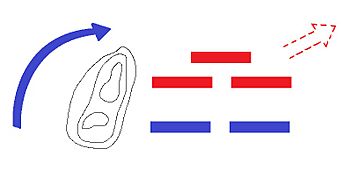Turning movement facts for kids

A turning movement , also called a wide envelopment is a maneuver designed to pass around the enemy's front to strike a vital part of the enemy's rear. It is a military tactic where a command is divided into two parts. The first part holds the enemy from the front while the other part moves around to attack the enemy's rear or flank. Unlike an envelopment or a flanking maneuver, the two forces operate beyond the distance where they could usually support each other. It is often easier for an enemy force to avoid an envelopment than it is to avoid a turning movement. To counter a turning movement, the enemy must either abandon their position or turn to meet the new threat. The turning movement is a variation of the envelopment tactic. Another difference is that the turning movement often seeks to avoid enemy contact until they are deep in the enemy's rear. Faced with a new threat in his rear area, the enemy is "turned" out of his defensive position and forced to act.
Examples
An early example of a turning movement was by Julius Caesar in 48 BC. One of Napoleon I of France's favorite tactics was the "Strategy of Indirect Approach" or the turning movement. One corps of his army would hold the enemy's attention while the main force would move behind the enemy in a wide circle. Ideally he would use the terrain to hide the turning movement. He used this to great effect during his 1805 Ulm Campaign. He repeated his success with this tactic at the Battle of Jena–Auerstedt in 1806, and at the Battle of Friedland in 1807.
The famous "left hook" maneuver by American and French troops during Operation Desert Storm was another example of a turning movement. Paratroopers of the American 82nd Airborne Division in vehicles along with the French 6th Light Armoured Brigade moved up the flanks. At the same time the 101st Airborne Division made the largest helicopter assault in history in the rear of Saddam Hussein's Republican Guard to cut off their retreat.
Related pages
- Envelopment
- Pincer movement (also called a double-envelopment)
- Flanking maneuver
- Rearguard
- Attrition warfare
- Feigned retreat
- Preemptive war
- Oblique order
- Shock tactics

